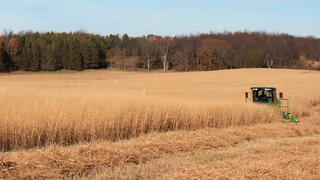Ecosystem carbon balances on CRP grassland conversion to cropping systems

Land use changes into and out of agricultural production can influence ecosystem carbon balance for many years.
The Science
Bioenergy cropping systems can act as sinks or sources of atmospheric carbon dioxide, depending on the balance between the formation and decomposition of organic carbon.
The Impact
Interactions among land use history, climate, crop species, and management practices can affect the formation and/or decomposition of soil organic carbon. Land use conversions from uncultivated or abandoned lands into agriculture, retirement of agricultural lands out of production, or a shift in management practices on existing agricultural lands are common land use changes that may substantially alter ecosystem carbon balances.
Summary
GLBRC scientists examined ecosystem carbon balances for eight years following the conversion of 22-year old Conservation Reserve Program (CRP) grasslands and formerly tilled agricultural fields (AGR) to annual (continuous no-till corn) and perennial (switchgrass and restored prairie) cropland. An unconverted CRP field was maintained as a historical reference.
Ecosystem carbon balance was calculated by adding the carbon removed in harvested biomass to the net ecosystem carbon exchange measured using the eddy covariance method, which measures the movement of CO2 between the cropping system and the atmosphere. The cumulative carbon balance of the corn and perennial systems on former CRP fields showed that these systems were a net carbon source to the atmosphere over the 8-year period while on former AGR fields, the perennial systems were net carbon sinks and the corn system near-neutral. The corn system on the CRP field will likely reach a new lower soil carbon equilibrium at least 14 years after conversion but will never regain the carbon lost upon conversion under current no- till management with residue partially removed. On the other hand, the perennial systems could fully regain in ∼14 years the carbon lost following conversion.
Results suggest that converting croplands to grasslands results in immediate carbon gains whereas converting grasslands to croplands results in permanent (no-till corn with partial residue removal) or temporary (perennial herbaceous crops) net carbon loss to the atmosphere. This has significant implications for global climate change mitigation where biomass production from annual and perennial crops is promoted to avoid fossil-fuel carbon emissions (biofuel) or to remove CO2 from the atmosphere (bioenergy carbon capture and storage).
Contacts (BER PM)
N. Kent Peters
kent.peters@science.doe.gov, 301-903-5549
(PI Contact)
G. Phil Robertson
robert30@msu.edu
Funding
DOE Great Lakes Bioenergy Research Center DOE BER Office of Science. Grant Number: DE-FC02-07ER64494.
Publications
Abraha, M. et al. “Ecosystem carbon exchange on conversion of Conservation Reserve Program grasslands to annual and perennial cropping systems” Agricultural and Forest Meteorology DOI:10.1016/j.agrformet.2018.02.016